Efficient Cyberattack Detection Methods in Industrial Control Systems
Abstract
1. Introduction
1.1. Related Works
1.2. Research Gap and Article Contribution
1.3. Article Structure
2. Materials and Methods
2.1. Laboratory Test Bed
- FLU, FLB, FRU, and FRB fans, with values from 0 to 100;
- HL and HR heaters, with values from 0 to 100.
- TL, TM, TR, and TF bench temperature, with values from −55.0 °C to +125.0 °C;
- TA ambient temperature, with values from −55.0 °C to +125.0 °C;
- C current measurement;
- V voltage measurement.
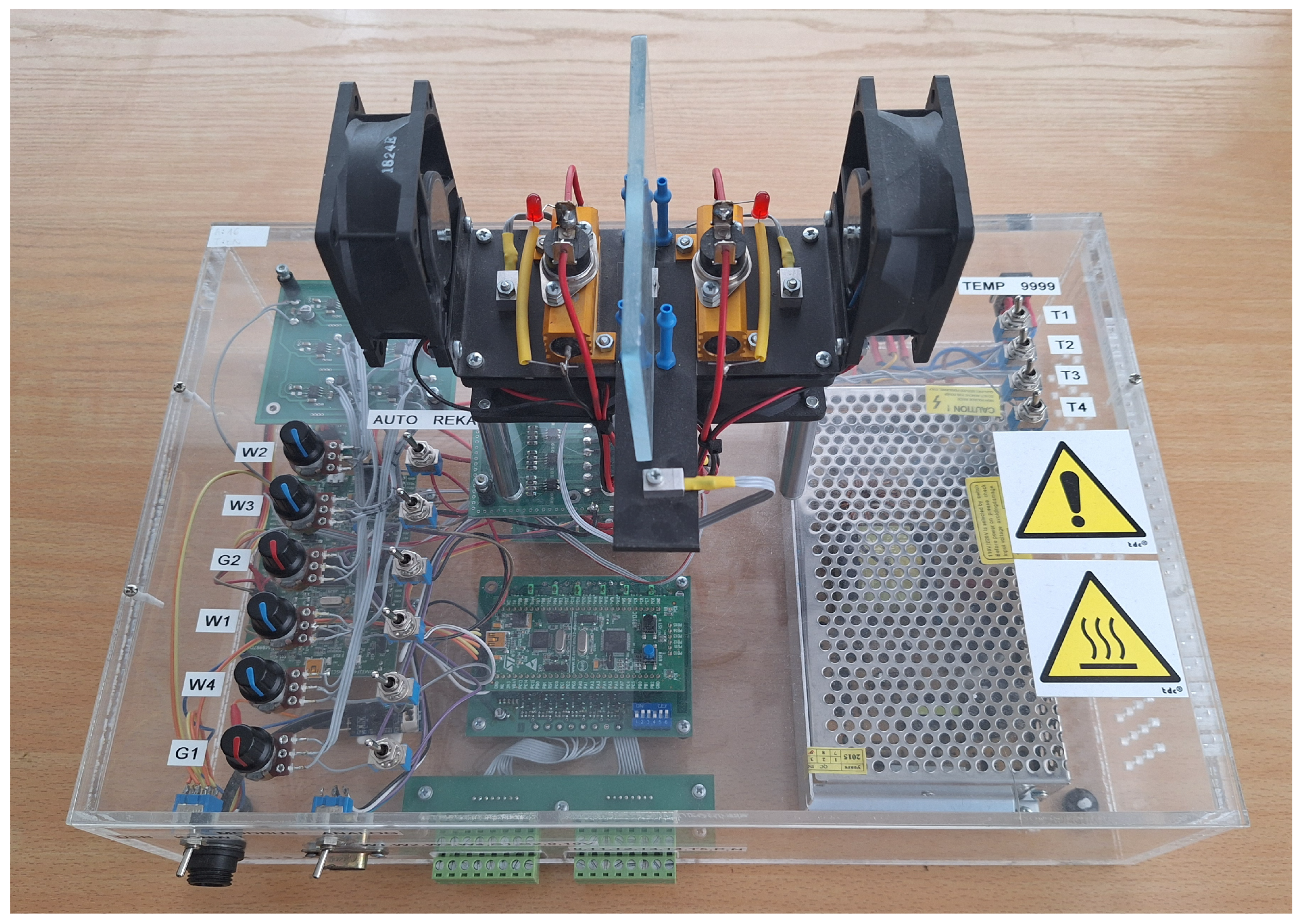
- is the left heater control signal (manipulated variable in the tested control system); , ;
- is the temperature measured on the left-hand-side of the laboratory stand (process variable in the tested control system); °C, °C;
- is the left fan control signal (disturbance variable in the tested control system); , .
2.2. Control System Operation in Nominal Conditions
2.3. Attack Scenarios and Detection Methods
- Are easy to implement;
- Are efficient in detecting a cyberattack;
- Generate few false alarms.
2.3.1. Method #1: Verification of the Control Value
Attack Scenario
Detection Mechanism

2.3.2. Method #2: Detection of Sudden Change in Output Variable
Attack Scenario
Detection Mechanism

2.3.3. Method #3: Copy of Controller Parameters Used to Detect an Attack
Attack Scenario

Detection Mechanism
2.3.4. Method #4: Using Golden Run in an Attack Detection
Attack Scenario
- To conduct the experiments depicted in Figures 8 and 12,the attack scenario described in Section 2.3.1, also used to obtain the result shown in Figure 4, was applied.
- To conduct the experiments depicted in Figures 9 and 13, the attack scenario described in Section 2.3.2, also used to obtain the result shown in Figure 5, was applied.
- To conduct the experiments depicted in Figures 10, 11, 14 and 15, the attack scenarios described in Section 2.3.3, also used to obtain the result shown in Figures 6 and 7, were applied.
Detection Mechanism
3. Results and Discussion
3.1. Method #1: Verification of the Control Value
3.2. Method #2: Detection of Sudden Change in Output Variable
3.3. Method #3: Copy of Controller Parameters Used to Detect an Attack
3.4. Method #4: Using Golden Run in an Attack Detection
Obtained Results: Laboratory Experiments
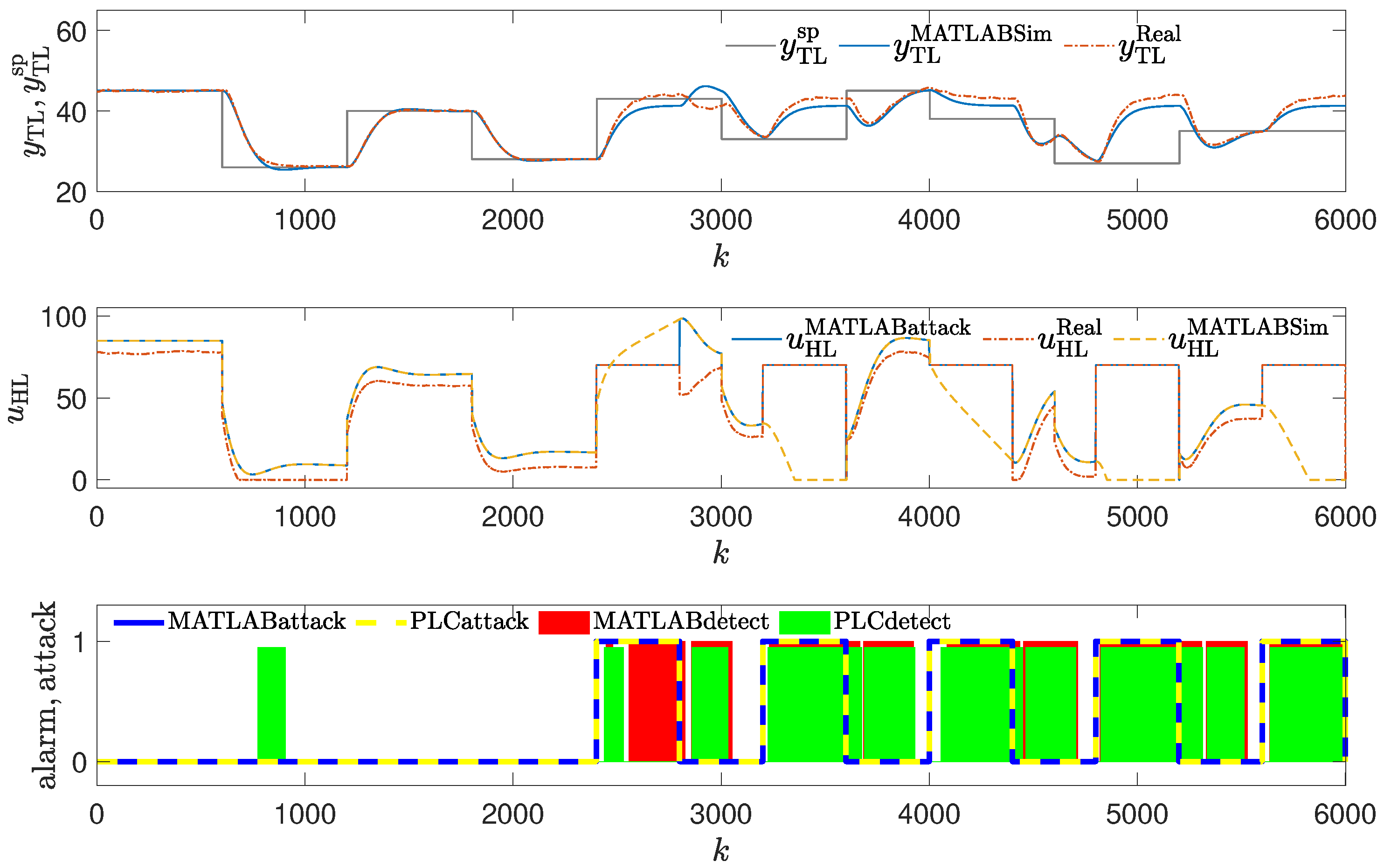

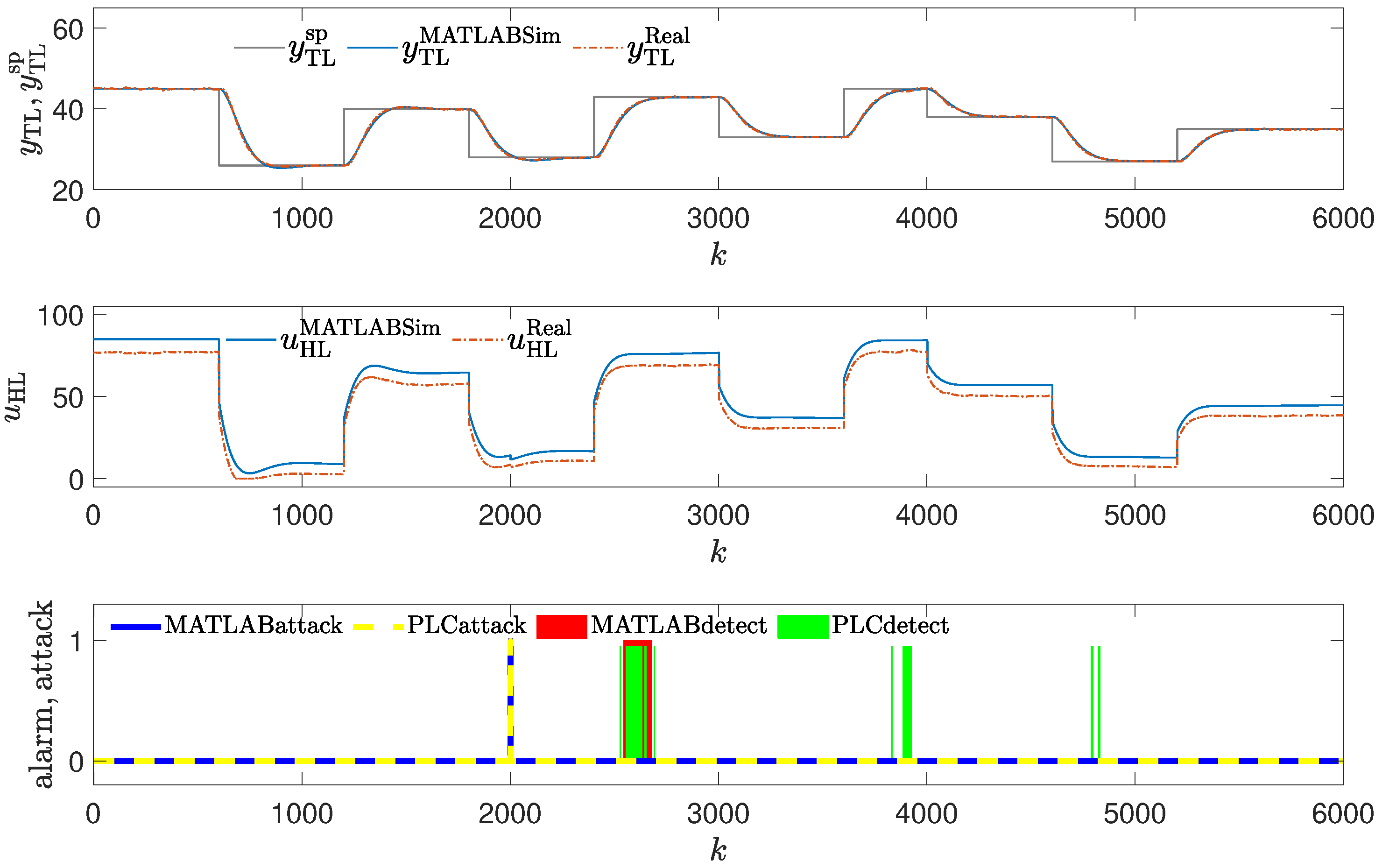
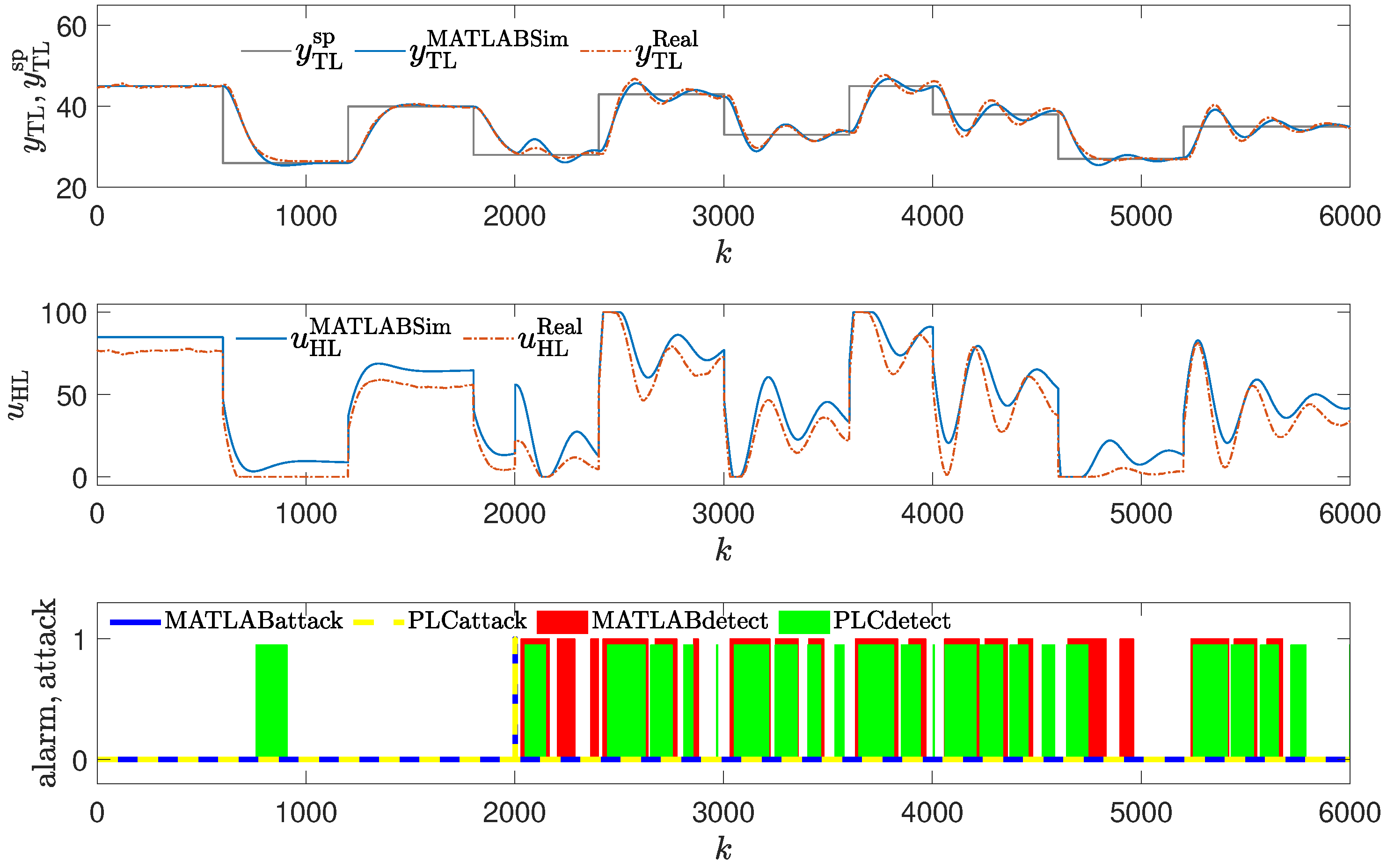
3.5. Comparison of Performance Metrics
4. Conclusions
Author Contributions
Funding
Institutional Review Board Statement
Informed Consent Statement
Data Availability Statement
Conflicts of Interest
Abbreviations
| HMI | Human–Machine Interface |
| IT | Information technology |
| MAE | Mean Absolute Error |
| MSE | Mean Squared Error |
| MV | Manipulated variable |
| OT | Operational technology |
| PI | Proportional–Integral |
| PID | Proportional–Integral–Derivative |
| PLC | Programmable Logic Controller |
| PV | Process variable |
| PWM | Pulse-Width Modulation |
| SCADA | Supervisory Control and Data Acquisition |
References
- Toker, O.; Ozdemir, O. Physical-layer Cyberattack Resilient OFDM Automotive Radars. In Proceedings of the 2020 IEEE Vehicular Networking Conference (VNC), New York, NY, USA, 16–18 December 2020. [Google Scholar]
- Hou, B.; Zeng, S.; Xi, B.; Jia, S.; Guo, Q.; Xu, L.; Sun, H. Performance of Neighborhood-Watch-Based Resilient Distributed Energy Management Algorithm Under Different Types of Cyberattacks. In Proceedings of the 2021 IEEE 4th International Electrical and Energy Conference (CIEEC), Wuhan, China, 28–30 May 2021; pp. 1–5. [Google Scholar]
- Zabetian-Hosseini, A.; Mehrizi-Sani, A.; Liu, C.C. Cyberattack to Cyber-Physical Model of Wind Farm SCADA. In Proceedings of the IECON 2018—44th Annual Conference of the IEEE Industrial Electronics Society, Washington, DC, USA, 21–23 October 2018; pp. 4929–4934. [Google Scholar]
- Colter, J.; Kinnison, M.; Henderson, A.; Schlager, S.M.; Bryan, S.; O’Grady, K.L.; Abballe, A.; Harbour, S. Testing the Resiliency of Consumer Off-the-Shelf Drones to a Variety of Cyberattack Methods. In Proceedings of the 2022 IEEE/AIAA 41st Digital Avionics Systems Conference (DASC), Portsmouth, VA, USA, 18–22 September 2022; pp. 1–5. [Google Scholar]
- Mu, L.; Zhao, E.; Wang, Y.; Zomaya, A.Y. Buoy Sensor Cyberattack Detection in Offshore Petroleum Cyber-Physical Systems. IEEE Trans. Serv. Comput. 2020, 13, 653–662. [Google Scholar] [CrossRef]
- Khaw, Y.M.; Abiri Jahromi, A.; Arani, M.F.M.; Sanner, S.; Kundur, D.; Kassouf, M. A Deep Learning-Based Cyberattack Detection System for Transmission Protective Relays. IEEE Trans. Smart Grid 2021, 12, 2554–2565. [Google Scholar] [CrossRef]
- Pazouki, S.; Bibek, K.C.; Alkhwaildi, H.A.; Asrari, A. Modelling of Smart Homes Affected by Cyberattacks. In Proceedings of the 2020 52nd North American Power Symposium (NAPS), Tempe, AZ, USA, 11–13 April 2021; pp. 1–6. [Google Scholar]
- Zhang, Y.; Jiang, Y.; Xu, A.; Hong, C.; Chen, J. Method to Evaluate the Impact of Cyberattacks against Charging Piles on Distribution Network. In Proceedings of the 2020 12th IEEE PES Asia-Pacific Power and Energy Engineering Conference (APPEEC), Nanjing, China, 20–23 September 2020; pp. 1–5. [Google Scholar]
- Kbar, G.; Alazab, A. A Comprehensive Protection Method for Securing the Organization’s Network against Cyberattacks. In Proceedings of the 2019 Cybersecurity and Cyberforensics Conference (CCC), Melbourne, VIC, Australia, 8–9 May 2019; pp. 118–122. [Google Scholar]
- Sudar, K.; Deepalakshmi, P.; Nagaraj, P.; Muneeswaran, V. Analysis of Cyberattacks and its Detection Mechanisms. In Proceedings of the 2020 5th International Conference on Research in Computational Intelligence and Communication Networks (ICRCICN), Bangalore, India, 26–27 November 2020; pp. 12–16. [Google Scholar]
- Housh, M.; Kadosh, N.; Haddad, J. Detecting and Localizing Cyber-Physical Attacks in Water Distribution Systems without Records of Labeled Attacks. Sensors 2022, 22, 6035. [Google Scholar] [CrossRef] [PubMed]
- Gaggero, G.B.; Caviglia, R.; Armellin, A.; Rossi, M.; Girdinio, P.; Marchese, M. Detecting Cyberattacks on Electrical Storage Systems through Neural Network Based Anomaly Detection Algorithm. Sensors 2022, 22, 3933. [Google Scholar] [CrossRef] [PubMed]
- Yin, X.C.; Liu, Z.G.; Nkenyereye, L.; Ndibanje, B. Toward an Applied Cyber Security Solution in IoT-Based Smart Grids: An Intrusion Detection System Approach. Sensors 2019, 19, 4952. [Google Scholar] [CrossRef]
- Villalba, D.A.M.; Varon, D.F.M.; Pórtela, F.G.; Triana, O.A.D. Intrusion Detection System (IDS) with anomaly-based detection and deep learning application. In Proceedings of the 2022 V Congreso Internacional en Inteligencia Ambiental, Ingeniería de Software y Salud Electrónica y Móvil (AmITIC), San Jose, Costa Rica, 14–16 September 2022; pp. 1–4. [Google Scholar]
- Wang, W.; Wang, Z.; Zhou, Z.; Deng, H.; Zhao, W.; Wang, C.; Guo, Y. Anomaly detection of industrial control systems based on transfer learning. Tsinghua Sci. Technol. 2021, 26, 821–832. [Google Scholar] [CrossRef]
- Lysenko, S.; Bobrovnikova, K.; Shchuka, R.; Savenko, O. A Cyberattacks Detection Technique Based on Evolutionary Algorithms. In Proceedings of the 2020 IEEE 11th International Conference on Dependable Systems, Services and Technologies (DESSERT), Kyiv, Ukraine, 14–18 May 2020; pp. 127–132. [Google Scholar]
- Naik Sapavath, N.; Muhati, E.; Rawat, D.B. Prediction and Detection of Cyberattacks using AI Model in Virtualized Wireless Networks. In Proceedings of the 2021 8th IEEE International Conference on Cyber Security and Cloud Computing (CSCloud)/2021 7th IEEE International Conference on Edge Computing and Scalable Cloud (EdgeCom), Washington, DC, USA, 26–28 June 2021; pp. 97–102. [Google Scholar]
- Tang, Z.; Jiao, J.; Zhang, P.; Yue, M.; Chen, C.; Yan, J. Enabling Cyberattack-Resilient Load Forecasting through Adversarial Machine Learning. In Proceedings of the 2019 IEEE Power & Energy Society General Meeting (PESGM), Atlanta, GA, USA, 4–8 August 2019; pp. 1–5. [Google Scholar]
- Kao, J.B.; Jiang, J.R. Anomaly Detection for Univariate Time Series with Statistics and Deep Learning. In Proceedings of the 2019 IEEE Eurasia Conference on IOT, Communication and Engineering (ECICE), Yunlin, Taiwan, 3–6 October 2019; pp. 404–407. [Google Scholar]
- Wang, H.; Tang, M.; Park, Y.; Priebe, C.E. Locality Statistics for Anomaly Detection in Time Series of Graphs. IEEE Trans. Signal Process. 2014, 62, 703–717. [Google Scholar] [CrossRef]
- Heymann, S.; Latapy, M.; Magnien, C. Outskewer: Using Skewness to Spot Outliers in Samples and Time Series. In Proceedings of the 2012 IEEE/ACM International Conference on Advances in Social Networks Analysis and Mining, Istanbul, Turkey, 26–29 August 2012; pp. 527–534. [Google Scholar]
- Wu, P.; Zhang, J.; Luo, S.; Song, Y.; Zhang, J.; Wang, Y. A Fusion Adaptive Cubature Kalman Filter Approach for False Data Injection Attack Detection of DC Microgrids. Electronics 2024, 13, 1612. [Google Scholar] [CrossRef]
- Söğüt, E.; Erdem, O.A. A Multi-Model Proposal for Classification and Detection of DDoS Attacks on SCADA Systems. Appl. Sci. 2023, 13, 5993. [Google Scholar] [CrossRef]
- Siva Kumar, C.; Kolla, H.; Sravya, B.; Sri, D.L.; Nikitha, G. Obtrusion Unmasking of Machine Learning-Based Analysis of Imbalanced Network Traffic. In Proceedings of the 2023 International Conference on Computer Communication and Informatics (ICCCI), Coimbatore, India, 23–25 January 2023. [Google Scholar]
- Liu, H.; Lang, B. Machine Learning and Deep Learning Methods for Intrusion Detection Systems: A Survey. Appl. Sci. 2019, 9, 4396. [Google Scholar] [CrossRef]
- Ahsan, M.; Nygard, K.E.; Gomes, R.; Chowdhury, M.M.; Rifat, N.; Connolly, J.F. Cybersecurity Threats and Their Mitigation Approaches Using Machine Learning—A Review. J. Cybersecur. Priv. 2022, 2, 527–555. [Google Scholar] [CrossRef]
- Govea, J.; Gaibor-Naranjo, W.; Villegas-Ch, W. Transforming Cybersecurity into Critical Energy Infrastructure: A Study on the Effectiveness of Artificial Intelligence. Systems 2024, 12, 165. [Google Scholar] [CrossRef]
- Chae, Y.; Katenka, N.; DiPippo, L. An Adaptive Threshold Method for Anomaly-based Intrusion Detection Systems. In Proceedings of the 2019 IEEE 18th International Symposium on Network Computing and Applications (NCA), Cambridge, MA, USA, 26–28 September 2019; pp. 1–4. [Google Scholar]
- Zarzycki, K.; Chaber, P.; Cabaj, K.; Ławryńczuk, M.; Marusak, P.; Nebeluk, R.; Plamowski, S. Wojtulewicz, A. GAN Neural Networks Architectures for Testing Process Control Industrial Network Against Cyber-Attacks. IEEE Access. 2023, 11, 49587–49600. [Google Scholar] [CrossRef]
- Zarzycki, K.; Chaber, P.; Cabaj, K.; Ławryńczuk, M.; Marusak, P.; Nebeluk, R.; Plamowski, S.; Wojtulewicz, A. Forgery Cyber-Attack Supported by LSTM Neural Network: An Experimental Case Study. Sensors 2023, 23, 6778. [Google Scholar] [CrossRef] [PubMed]
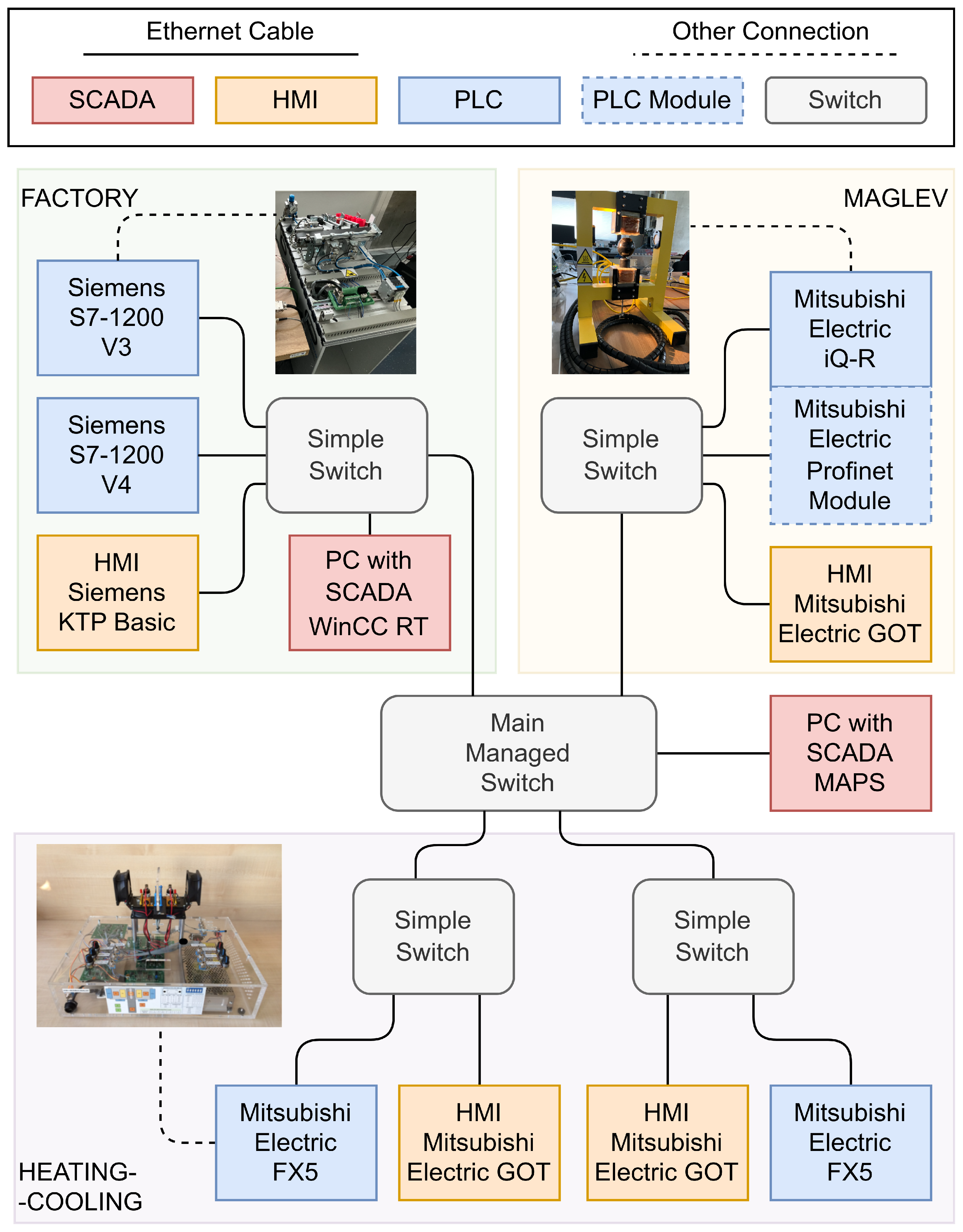
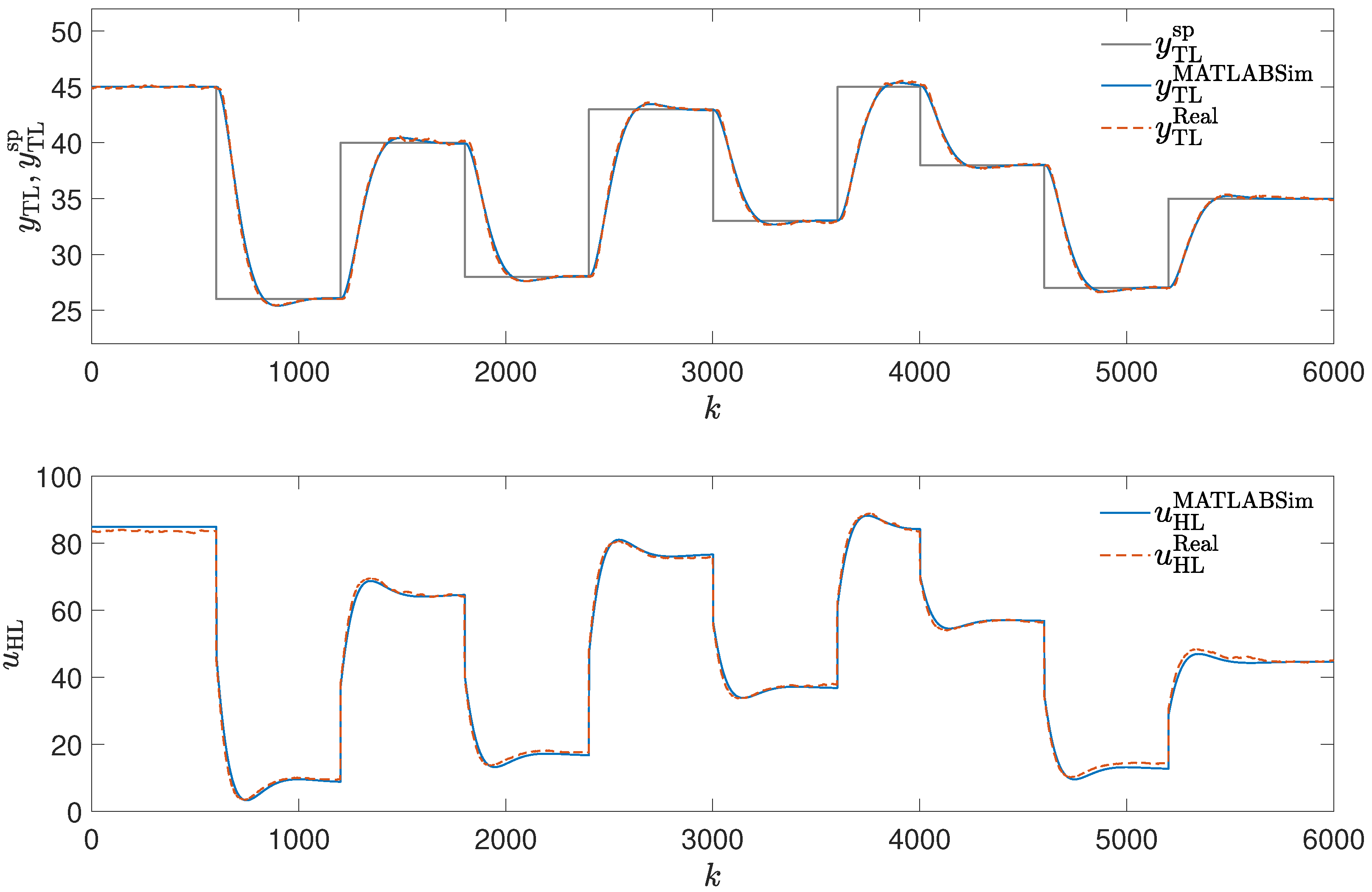

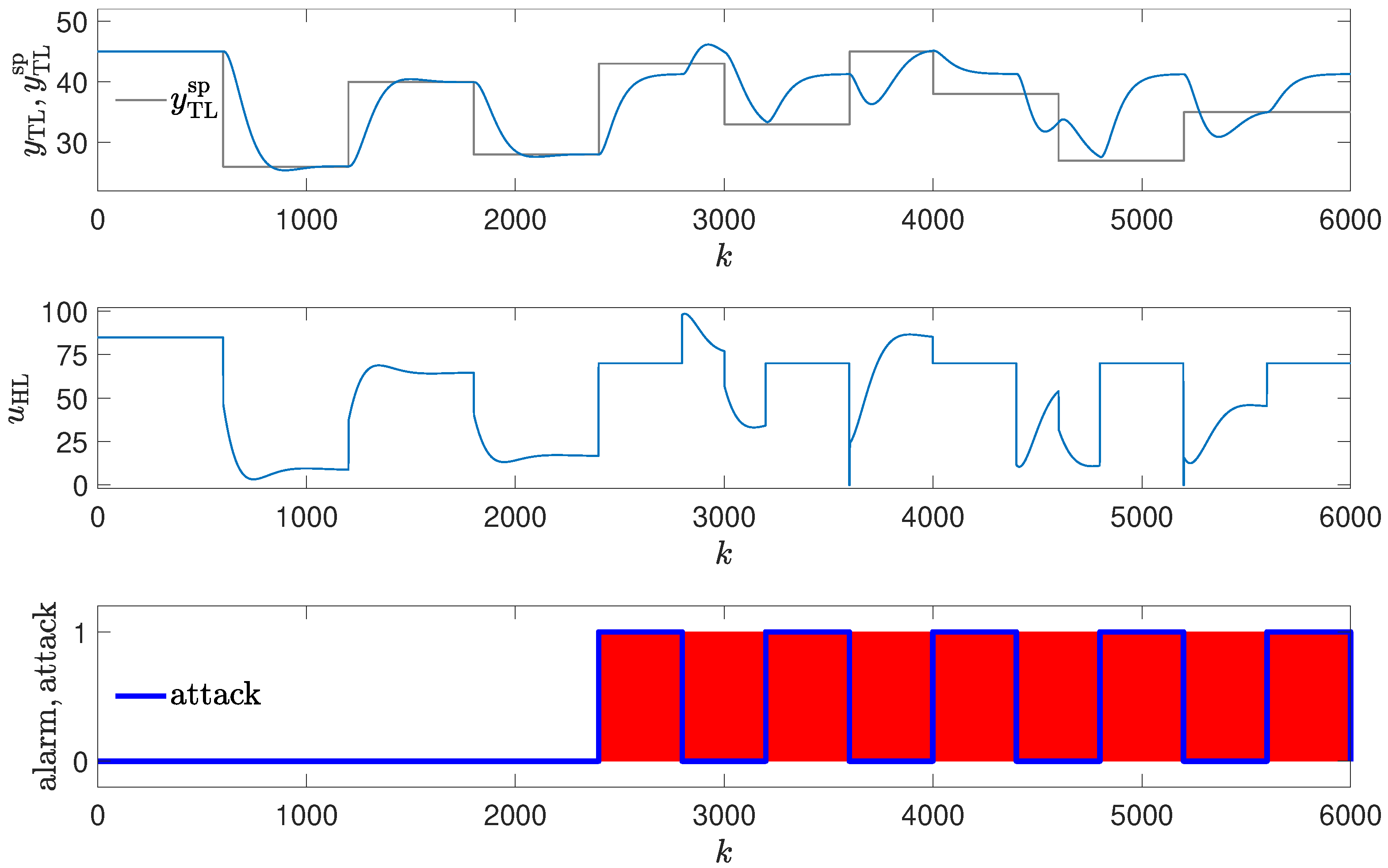
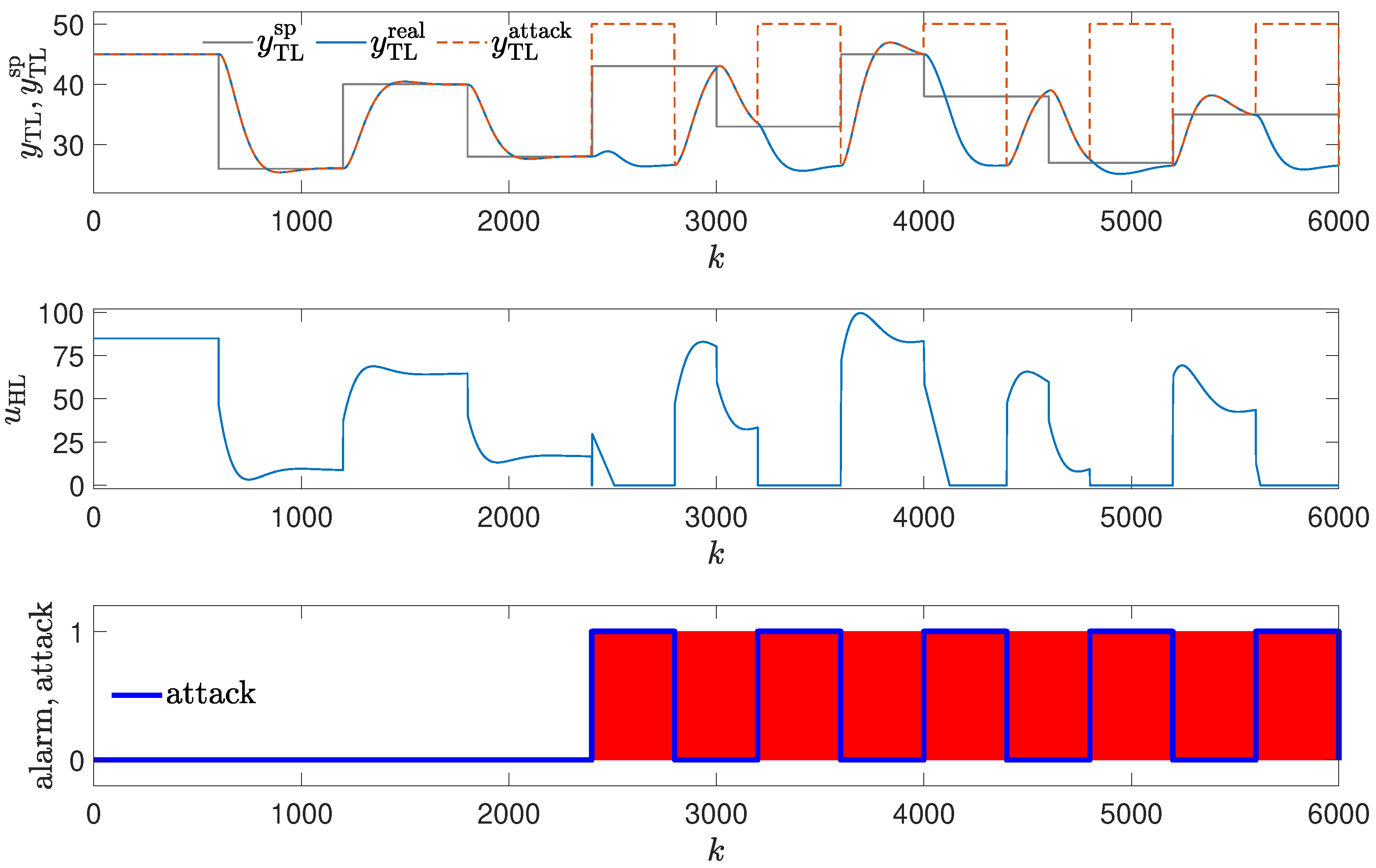

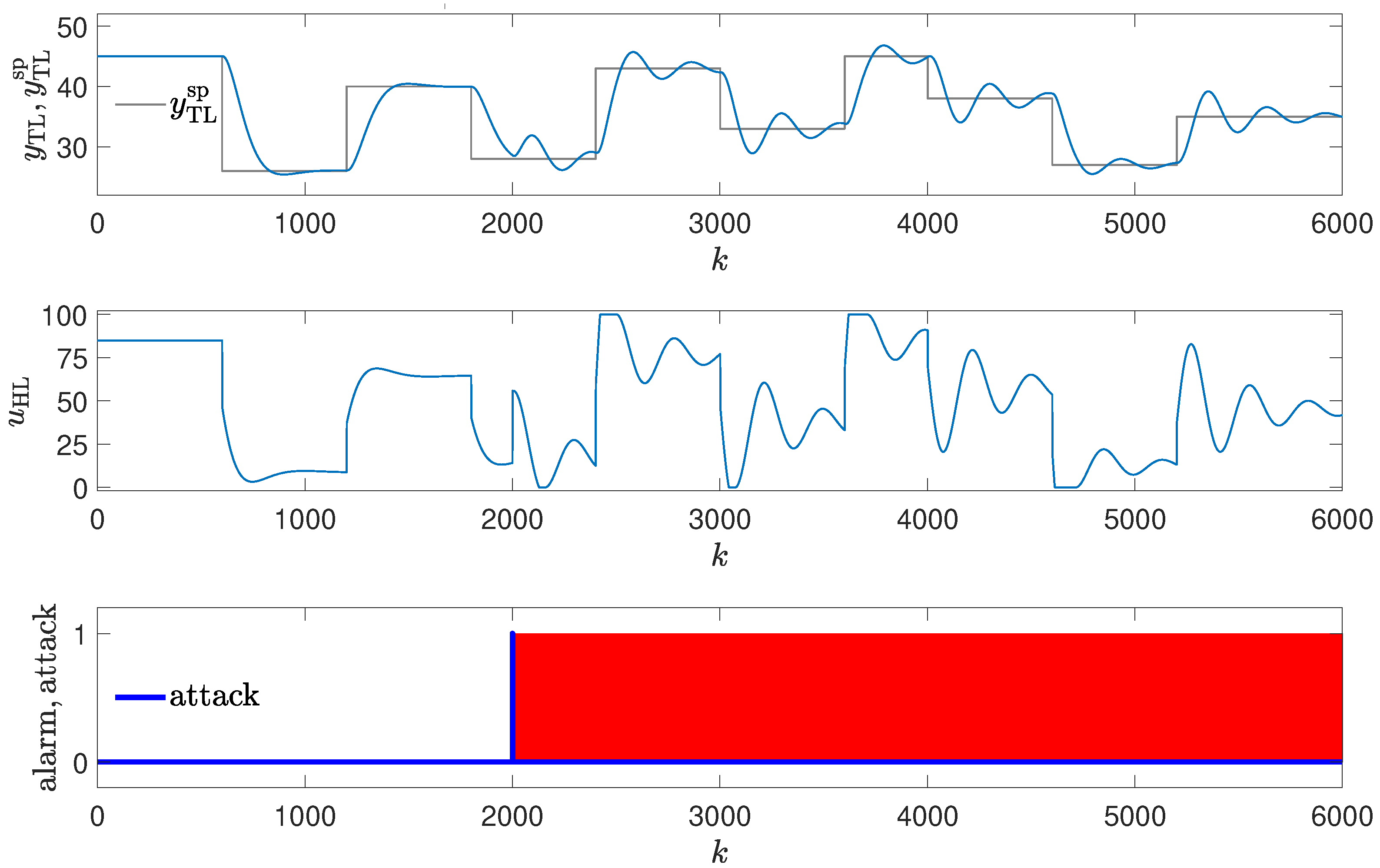
| Attack Scenario | Detection Method | MSE | MAE |
|---|---|---|---|
| No attack | – | ||
| First attack | MV copy | ||
| First attack | Golden run | ||
| Second attack | PV copy | ||
| Second attack | Golden run | ||
| Third attack v. 1 | Copy of parameters | ||
| Third attack v. 1 | Golden run | ||
| Third attack v. 2 | Copy of parameters | ||
| Third attack v. 2 | Golden run |
| Attack Scenario | Detection Method | Detection Rate | False Positive Rate | Precision | Recall | Time to Detect (First Attack/Mean) |
|---|---|---|---|---|---|---|
| First attack | MV copy | |||||
| First attack | Golden run | |||||
| Second attack | PV copy | |||||
| Second attack | Golden run | |||||
| Third attack v. 1 | Copy of parameters | |||||
| Third attack v. 1 | Golden run | |||||
| Third attack v. 2 | Copy of parameters | |||||
| Third attack v. 2 | Golden run |
| Attack Scenario | Detection Method | Detection Rate | False Positive Rate | Precision | Recall | Time to Detect (First Attack/Mean) |
|---|---|---|---|---|---|---|
| First attack | Golden run | |||||
| Second attack | Golden run | |||||
| Third attack v. 1 | Golden run | |||||
| Third attack v. 2 | Golden run |
Disclaimer/Publisher’s Note: The statements, opinions and data contained in all publications are solely those of the individual author(s) and contributor(s) and not of MDPI and/or the editor(s). MDPI and/or the editor(s) disclaim responsibility for any injury to people or property resulting from any ideas, methods, instructions or products referred to in the content. |
© 2024 by the authors. Licensee MDPI, Basel, Switzerland. This article is an open access article distributed under the terms and conditions of the Creative Commons Attribution (CC BY) license (https://creativecommons.org/licenses/by/4.0/).
Share and Cite
Marusak, P.; Nebeluk, R.; Wojtulewicz, A.; Cabaj, K.; Chaber, P.; Ławryńczuk, M.; Plamowski, S.; Zarzycki, K. Efficient Cyberattack Detection Methods in Industrial Control Systems. Sensors 2024, 24, 3860. https://doi.org/10.3390/s24123860
Marusak P, Nebeluk R, Wojtulewicz A, Cabaj K, Chaber P, Ławryńczuk M, Plamowski S, Zarzycki K. Efficient Cyberattack Detection Methods in Industrial Control Systems. Sensors. 2024; 24(12):3860. https://doi.org/10.3390/s24123860
Chicago/Turabian StyleMarusak, Piotr, Robert Nebeluk, Andrzej Wojtulewicz, Krzysztof Cabaj, Patryk Chaber, Maciej Ławryńczuk, Sebastian Plamowski, and Krzysztof Zarzycki. 2024. "Efficient Cyberattack Detection Methods in Industrial Control Systems" Sensors 24, no. 12: 3860. https://doi.org/10.3390/s24123860
APA StyleMarusak, P., Nebeluk, R., Wojtulewicz, A., Cabaj, K., Chaber, P., Ławryńczuk, M., Plamowski, S., & Zarzycki, K. (2024). Efficient Cyberattack Detection Methods in Industrial Control Systems. Sensors, 24(12), 3860. https://doi.org/10.3390/s24123860







